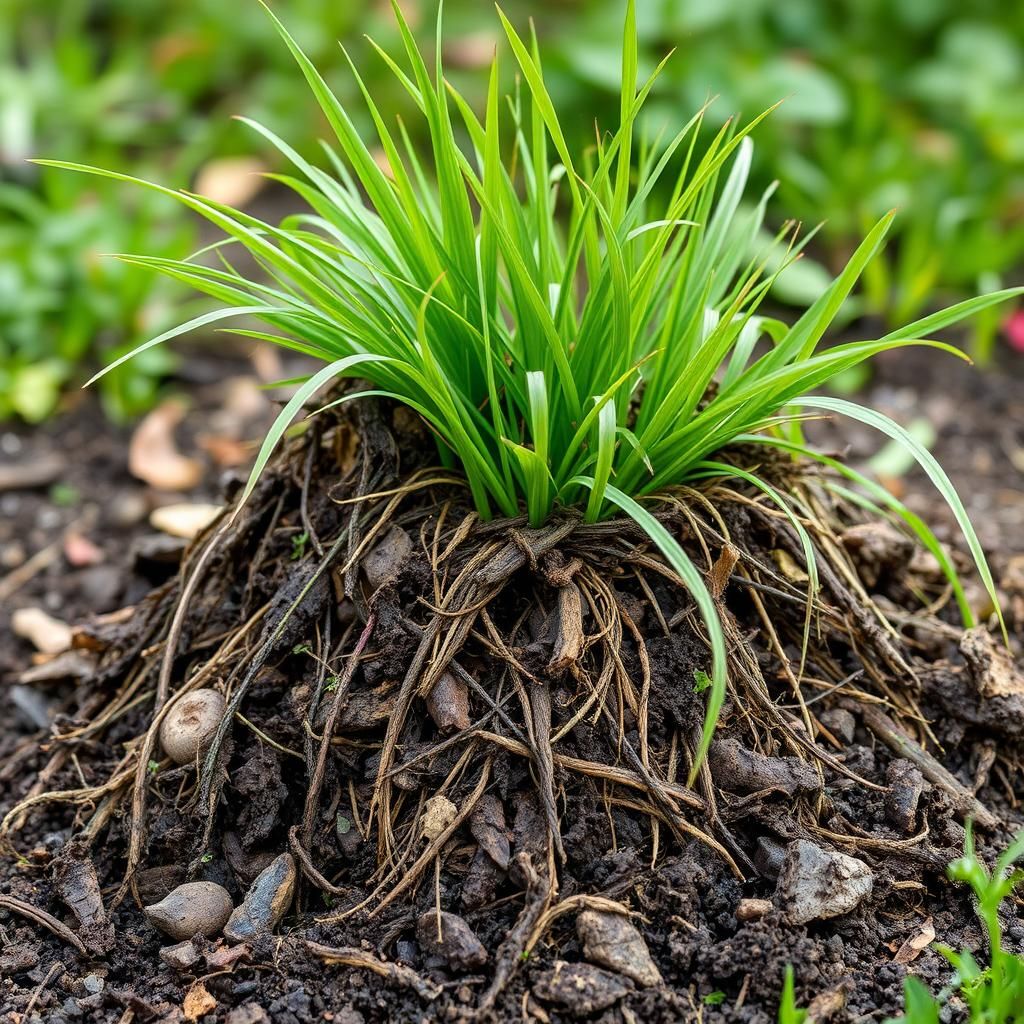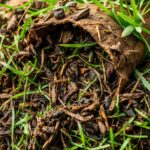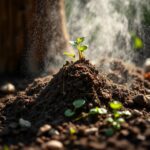Is Rotted Grass a Good Compost? Discover the Benefits and Uses for Your Garden

Rotted grass, often overlooked in the gardening community, can be a valuable addition to your compost pile. As it decomposes, it enriches the soil and provides essential nutrients for your plants. This article explores the benefits of using rotted grass in composting, highlighting its role in improving soil structure, enhancing moisture retention, and promoting healthy plant growth. Additionally, we will discuss practical applications and tips for incorporating rotted grass into your gardening routine. Discover how this simple green waste can transform your garden into a thriving ecosystem, ensuring robust and vibrant plant life.
Is Rotted Grass a Good Compost?
Rotted grass can indeed be a good compost material, as it is rich in nitrogen, which is essential for the decomposition process and provides valuable nutrients for plants. When grass clippings undergo decay, they create a nutrient-dense organic matter that improves soil structure, enhances moisture retention, and encourages healthy microbial activity. However, it is crucial to ensure that the grass is not contaminated with pesticides or herbicides, as these chemicals can harm the beneficial organisms in your compost pile and the plants that will benefit from the compost. Additionally, incorporating a balance of other organic materials, such as greens and browns, will optimize the composting process, leading to richer compost.
Benefits of Rotted Grass in Compost
Adding rotted grass to compost offers numerous benefits, including improved nutrient content and enhanced soil structure. The nitrogen and other nutrients provided by rotted grass contribute significantly to the nutrient profile of the compost, making it an excellent option for fertilizing gardens and landscapes. Furthermore, rotted grass can improve soil aeration and drainage when mixed into the soil, fostering a better environment for root growth and microbial activity.
How to Prepare Rotted Grass for Composting
To effectively prepare rotted grass for composting, it is important to ensure that the grass is fully decomposed. You can achieve this by collecting grass clippings and allowing them to sit in a pile or bin for several weeks. Turning the pile regularly can help accelerate the composting process by introducing oxygen, which is essential for the activity of aerobic microbes. Additionally, keeping the moisture level consistent will promote optimal conditions for nutrient breakdown.
Potential Drawbacks of Using Rotted Grass
While rotted grass has many advantages, there are some potential drawbacks to consider. If the grass is not adequately composted, it may create a foul odor or attract pests. Moreover, grass treated with herbicides can contaminate the compost, potentially affecting the growth of plants. It is also important to monitor the carbon-to-nitrogen ratio to avoid making the compost too rich in nitrogen, which can lead to composting issues such as excessive heat or slow decomposition.
Mixing Rotted Grass with Other Compost Materials
To create a well-rounded compost pile, it is beneficial to mix rotted grass with a variety of other organic materials. Combining greens (such as kitchen scraps and nitrogen-rich materials) with browns (like dried leaves, straw, or cardboard) will help balance the carbon-to-nitrogen ratio. This diversity increases the microbial activity in the compost, ensuring a faster and more efficient breakdown of organic matter, leading to a nutrient-rich compost for gardening purposes.
Using Rotted Grass in the Garden
Utilizing rotted grass in the garden can yield great results when applied either as a top dressing or mixed into the soil. It can improve soil fertility, boost moisture retention, and support healthy plant growth thanks to its enriching nutrients. When mixed into the soil, it can enhance the soil's structure, making it easier for roots to penetrate while promoting beneficial microbial life. To maximize its benefits, it is best to incorporate rotted grass into garden beds before planting and allow it to integrate well with the existing soil.
| Aspect | Details |
|---|---|
| Benefits | Improved nitrogen content, enhanced soil structure, increased moisture retention. |
| Preparation | Collect grass clippings, allow proper decomposition, turn pile for aeration. |
| Drawbacks | Pest attraction, odor issues, potential herbicide contamination. |
| Mixing | Balance with greens and browns for efficient composting. |
| Gardening Use | Top dressing or mixing into soil for improved fertility and moisture retention. |
What to do with rotten grass clippings?

When you have accumulated rotten grass clippings, it's essential to handle them properly to avoid potential odors and pest issues. Here are several effective ways to deal with this organic matter:
Composting Rotten Grass Clippings
Composting is a fantastic method to recycle rotten grass clippings into nutrient-rich compost. The process helps break down the organic material, returning valuable nutrients to the soil. Here’s how to do it effectively:
- Mix with Other Materials: Combine the rotten grass clippings with brown materials like dried leaves, straw, or cardboard to create a balanced compost mix.
- Maintain Moisture: Ensure that the compost pile is moist but not saturated for optimal decomposition.
- Turn Regularly: Aerate the compost pile every few weeks to help speed up the decomposition process and control odors.
Using as Mulch
Another excellent way to utilize rotten grass clippings is by applying them as mulch. This can improve soil moisture retention and provide nutrients to the plants:
- Spread Thinly: Apply a thin layer of the clippings around plants and garden beds to prevent mold and odors.
- Control Weeds: The mulch can help suppress weed growth by blocking sunlight.
- Enhance Soil Quality: As the clippings decompose, they will enrich the soil with organic matter.
Adding to the Garden Bed
Incorporating rotten grass clippings directly into the garden bed can also be beneficial. This technique improves soil structure and promotes microbial activity:
- Mix into Soil: Till or blend the rotten clippings into the top layer of soil in garden beds for better nutrient distribution.
- Boost Microbial Life: The decomposing clippings will attract beneficial microorganisms that enhance soil health.
- Test Soil pH: It's important to monitor soil pH post-application to ensure balance.
Creating Green Manure
Rotten grass clippings can be turned into green manure, which adds nutrients to the soil and enhances its fertility. Here’s how to do it:
See also:
- Cut and Incorporate: Chop the rotten clippings and mix them into the soil to decompose and enrich the soil.
- Choose the Right Time: Apply before planting to allow enough time for decomposition.
- Monitor Nutrients: Keep track of nutrient levels, as the breakdown of clippings will release nitrogen and other elements.
Disposing of Rotten Grass Clippings
If the clippings are excessively rotten and unusable for composting or gardening, proper disposal is crucial to prevent any health hazards:
- Check Local Regulations: Some areas have specific guidelines for organic waste disposal.
- Use Yard Waste Bins: Place them in dedicated yard waste containers for collection by municipal services.
- Avoid Burning: Burning may not be allowed in many areas due to air quality regulations.
Can I use dead grass as compost?

Yes, you can use dead grass as compost. Dead grass is a carbon-rich material that can contribute significantly to the composting process. When added to a compost pile, it helps balance the nitrogen-rich green materials, creating an optimal environment for decomposition. However, there are certain considerations to keep in mind in order to maximize its benefits.
Benefits of Using Dead Grass in Compost
Using dead grass in your compost pile has several advantages:
- Carbon Content: Dead grass is high in carbon, which helps balance the nitrogen from other green materials.
- Soil Structure Improvement: Incorporating dead grass can enhance soil structure, improving aeration and drainage.
- Moisture Retention: Dead grass can help retain moisture in the compost, supporting microbial activity.
How to Prepare Dead Grass for Composting
Preparing dead grass for your compost pile involves several steps:
- Mow or Shred: Break down larger pieces of dead grass to speed up the decomposition process.
- Mix with Greens: Combine dead grass with green materials like kitchen scraps or fresh grass clippings.
- Maintain Balance: Keep an eye on the carbon to nitrogen ratio to ensure optimal composting conditions.
Potential Issues with Dead Grass in Compost
While dead grass can be beneficial, there are some potential issues to be aware of:
- Compaction: Layers of dead grass can become compacted, hindering airflow in the compost heap.
- Weed Seeds: If the dead grass contains weed seeds, it may introduce unwanted plants into your garden.
- Slow Decomposition: Very dry or brown grass might decompose more slowly if not adequately mixed with wetter materials.
How to Incorporate Dead Grass into Your Compost Pile
Incorporating dead grass into your compost pile is straightforward:
- Layering: Alternate layers of dead grass and other compost materials to create a balanced mix.
- Watering: Ensure that the compost pile is kept moist but not soggy to encourage microbial activity.
- Turning the Pile: Regularly turn the compost to aerate it, which will help the dead grass break down faster.
Alternative Uses for Dead Grass
Dead grass can also be repurposed in various ways:
- Mulch: Use dead grass as mulch around your garden to suppress weeds and retain moisture.
- Soil Amendment: Incorporate it directly into the soil to improve texture and fertility.
- Animal Bedding: Use it as bedding for chickens or other animals, as it can absorb moisture and odors.
Is rotting grass good fertilizer?

Rotting grass, commonly known as grass clippings or decayed grass, can indeed serve as an excellent fertilizer for gardens and lawns. When grass goes through the decomposition process, it transforms into a rich organic matter that enhances soil quality. This organic matter is packed with nutrients that promote plant growth. As a nitrogen-rich material, decomposed grass supports healthy development in various plant species.
Here are several benefits to consider regarding rotting grass as fertilizer:
- Nutrient Content: Decomposed grass is rich in essential nutrients such as nitrogen, phosphorus, and potassium, which are crucial for plant growth.
- Soil Structure Improvement: Adding rotting grass helps improve soil structure by increasing aeration and moisture retention, leading to healthier root systems.
- Weed Suppression: A layer of decomposed grass can help suppress weed growth by blocking sunlight and creating an inhospitable environment for weed seeds.
- Microbial Activity Enhancement: The decomposition process encourages beneficial microbial activity in the soil, which can help break down nutrients further and make them available to plants.
- Cost-Effectiveness: Using rotting grass as fertilizer is an economical way to recycle yard waste and reduce costs associated with purchasing commercial fertilizers.
Benefits of Using Rotting Grass as Fertilizer
Rotting grass provides numerous benefits for both home gardeners and professional horticulturists. It contributes significantly to the nutrient dynamics of the soil and improves the overall health of plants. The key benefits include:
- Enhanced Nutrient Supply: The nutrients released during the decomposition process are crucial for plant growth and help in achieving a lush garden.
- Environmental Sustainability: Using grass clippings reduces waste and promotes a sustainable gardening approach by recycling organic materials.
- Cost Savings: By utilizing free resources from your garden, you can cut down on fertilizer expenses.
How to Use Rotting Grass in Your Garden
Incorporating rotting grass into your garden can be done in various ways to maximize its benefits. Here are some methods to use it effectively:
See also:
- Mulching: Spread a layer of decomposed grass around plants to retain moisture and suppress weeds.
- Composting: Add rotting grass to your compost pile to enhance the compost's overall nutrient content.
- Soil Amendment: Mix decomposed grass into your garden soil before planting to enrich it.
Considerations When Using Rotting Grass
While rotting grass is beneficial, there are some considerations to keep in mind to ensure its effective use:
- Health of Grass: Ensure the grass is free of chemicals and disease to avoid introducing harmful substances into the soil.
- Balance with Other Materials: Combine with carbon-rich materials for a balanced compost to maintain optimal microbial activity.
- Avoid Odors: If using large amounts, allow proper aeration in your compost to prevent unpleasant smells during decomposition.
Potential Downsides of Using Rotting Grass
Though the advantages are significant, there can be downsides to consider when using rotting grass:
- Potential Pests: If not managed well, rotting grass can attract pests and insects.
- Nutrient Imbalance: Over-application can lead to a nutrient imbalance in the soil.
- Acidity Issues: Depending on the source, decomposing grass might alter soil pH levels, requiring monitoring.
Conclusion: The Role of Rotting Grass in Sustainable Gardening
In the pursuit of sustainable gardening practices, rotting grass can play a significant role in enriching soil quality, improving plant health, and contributing to environmental stewardship. It provides a natural and cost-effective option for enhancing garden productivity.
Can you put moldy grass in compost?

Moldy grass can be included in compost, but there are important factors to consider to ensure it contributes positively to the composting process. Mold is a type of fungus that thrives in moist environments, and its presence in grass indicates that the grass has started to break down. Here's a detailed look at the implications of adding moldy grass to your compost pile.
Benefits of Adding Moldy Grass to Compost
Adding moldy grass to compost can provide several benefits that can enhance the overall quality of the compost:
- Nutrient-Rich Material: Moldy grass is still an organic matter that can break down and release nutrients into the compost.
- Microbial Activity: The presence of mold can promote beneficial microbial activity, which is essential for composting.
- Improved Structure: Incorporating moldy grass can help improve the structure and aeration of the compost mix.
Potential Risks of Moldy Grass in Compost
While there are benefits, there are also potential risks to consider when adding moldy grass to compost:
- Pathogen Concerns: Some molds may carry pathogens that could potentially harm plants or humans.
- Odor Issues: Moldy material can produce unpleasant odors, affecting the quality of your compost.
- Imbalance in Composting: An excess of moldy materials might create an imbalance in carbon to nitrogen ratios.
How to Manage Moldy Grass in Compost
Managing moldy grass effectively can make a significant difference in the composting process. Here are some management tips:
- Layering: Layer moldy grass with dryer materials to balance moisture levels and prevent odors.
- Turn Regularly: Frequent turning of the compost pile helps aerate the material, promoting faster decomposition and reducing foul smells.
- Add Activators: Introducing composting activators can enhance microbial activity, helping to process moldy grass more efficiently.
Signs of Healthy Compost with Moldy Grass
When incorporating moldy grass into your compost, it's essential to recognize the signs of a healthy compost pile:
- Heat Generation: A healthy compost pile will generate heat, indicating effective microbial activity and breakdown.
- Earthy Smell: The odor should be pleasant and earthy, not foul, indicating that decomposition is taking place properly.
- Dark, Crumbly Texture: The end result should be dark and crumbly, signifying that all materials, including moldy grass, have decomposed adequately.
Alternatives to Composting Moldy Grass
If you decide not to add moldy grass to your compost, there are effective alternatives to consider:
- Mulching: Use moldy grass as mulch in garden beds, where it can suppress weeds and retain moisture.
- Discarding: If the mold is extensive and concerning, consider discarding it to avoid potential issues.
- Making Leaf Mold: Combine moldy grass with leaves to create leaf mold, a nutrient-rich additive for gardens.
Questions from Our Readers
Is rotted grass a good compost?
Rotted grass can be an excellent addition to compost. As it decomposes, it provides rich nutrients, aiding in the creation of a balanced compost mix. However, it’s essential to ensure that the grass is free from any chemical treatments to avoid harming plants in the future.
How can I use rotted grass in my compost pile?
To effectively use rotted grass, layer it into your compost pile along with other organic materials like kitchen scraps and leaves. This layering helps maintain an optimal balance of nitrogen and carbon, which is crucial for effective decomposition.
Should I add fresh grass clippings to my compost?
While fresh grass clippings can be added to compost, they should be used sparingly as they can mat together and create a foul odor. Mixing them with other materials and allowing them to dry slightly before adding can help reduce these issues.
See also:
What are the benefits of using rotted grass in compost?
Using rotted grass in compost enriches the soil with vital nutrients, improves soil structure, and increases moisture retention. It also contributes to a more diverse microbial life, which is essential for healthy plant growth.

If you want to read more articles like Is Rotted Grass a Good Compost? Discover the Benefits and Uses for Your Garden, we recommend you check out our Compost category.
Leave a Reply
Related Articles